|
|
| home |
| LAWRENCE
DAVIS. Children's Interactive Gallery. Everson Museum, Syracuse, New
York |
||||
| [in italiano] |
SUMMARY. The Children's Interactive Gallery is conceived as a provisional platform that challenges the conventional use of art museums. The gallery also develops a dialogue with its site, the late Modernist poured in place concrete character of the Everson Museum of Art in which it is housed; I.M. Pei's first museum, constructed in 1968. Intended to change every three or four years, the current configuration explores two significant aspects of the Museum's permanent holdings, American portraiture and its World renown ceramics collection.
|
[24jul2002] | ||
| > MUSEUM IN MOTION |
In the portrait section of the gallery museum docents and/or supporting text ask participants to compare a mid-nineteenth century portrait by Sanford Thayer to a contemporary photographic portrait by Cindy Sherman. Participants then question the art form in general terms and are asked to construct their own self-portrait though discussion, writing and drawing. The children then actualize their ideas by selecting from and dressing in a range of costumes and props provided in the gallery. After choosing a backdrop, one of four enlarged prints of a land or city-scape from the museum's collection, they sit for their own photographic portrait delivered via video printer contained in a video camera kiosk. In addition to producing a Polaroid-like print, the kiosk simultaneously transmits the video portrait to a TV monitor at the entry to the gallery.
|
|||
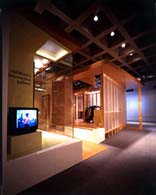 Entrance. 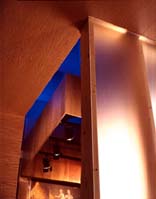 Ceiling detail. |
The ceramics section of the gallery recalls the early history of museum typology for its conceptual organization. This portion of the project is comprized of a table for children to make their own works of art out of plasticine and a wall-like "cabinet of curiosities" or "Wunderkammer" used to exhibit their works. Computers and drafting tables. I bambini in seguito attualizzano le loro idee scegliendo e indossando un costume da un guardaroba presente all'interno della galleria. Dopo aver scelto uno scenario che farą da fondale -tra quattro stampe ingrandite di paesaggi urbani o rurali prese dai quadri della collezione del museo- essi si siedono e posano per il proprio ritratto fotografico di fronte a una telecamera contenuta all'interno di un chiosco video. Oltre a produrre un'immagine tipo Polaroid attraverso una stampante, il video trasmette simultaneamente il ritratto a un monitor televisivo posizionato all'ingresso della galleria. This playful wall of cabinets also contains selected ceramic works from the Museum's collection. Dating back to the Enlightenment, the concept of the "Wunderkammer" evokes the spaces of the first collectors of exotic natural and cultural artifacts. As with the portrait section, the ceramics space invites visitors to re-think the museum experience, here exposing collecting, arranging and curating as culturally biased activities that are perpetually incomplete. For the most ambitious visitors the interactive ceramics gallery is an opportunity to produce and curate (or at least influence) an "exhibit" themselves in a creative exercise of arrangement which is ideally unencumbered by preconceived notions of the classification of art. In addition to portraiture and ceramics the gallery structure also has space for a number of interactive computers, blocks and other activities. A large space behind the principle space of the gallery provides an accessible and discrete place for weekend and summer children's art classes. CONCEPTUAL ISSUES |
 Wunderkammer and wardrobe. 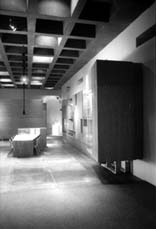 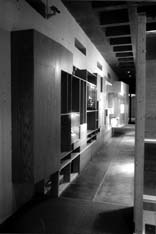 Wunderkammer. |
||
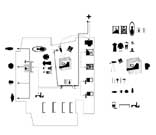 Diagram of functions. 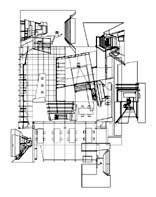 Plan with views. |
Collage: Using the incomplete and the fragment in the compositional, constructional and programmatic language of the project is a means of offering choice to the inhabitant of the gallery. It promotes a looser interpretation of the works of art and the museum itself as well as engaging the heterogeneous nature of contemporary space-making through multiple views, functional possibilities, materiality and meaning.
|
|||
|
Collecting: When one gathers a set of artifacts one is also constructing a system of arrangement. This structure of empowerment is historically a means used by cultural institutions to exert control over the direction of shared consciousness of any given issue. By allowing both the portrait images and the ceramic objects made by the children to be exhibited along side pieces from the Museum's permanent collection the gallery subtly subverts, or at least comments on, traditional cultural authority of the museum curator. Subject/Viewer Relationship: The process of "interactivity" itself challenges traditional subject/viewer relationships. Openings in the gallery's articulated skins and volumes further critique the subject/viewer theme by "framing" interior activities to viewers who may choose to experience the space from the outside. In this way the activity on the inside becomes an exhibit itself like all other exhibits in the museum, to be viewed in a conventional and passive manner. Immediate Context: In addition to commenting on the Everson's purpose as a conventional art museum, the Children's Interactive Gallery refers to the building's construction and formal character. The use of wood acts as a counterpoint to the heavy and monumental character of the Pei building. The frame and skin also refers to the form work of the highly crafted poured in place concrete building. Lastly, the gallery's location in the museum's basement and its promenade of spaces around the proscenium tower holding the portrait backdrops is a translation of a similar procession of gallery spaces which pin-wheel around the two story center atrium of the museum on the two floors above. Construction: The 2x6 wood frame and skins of oak veneer plywood and translucent Lexan offers a dexterous and plastic language which promotes multiple readings of formal and programmatic relationships. Most directly, the skin and frame construction is intended to articulate the process of building to visitors of the gallery. This palette is also a haptically appealing and familiar alternative to the "sacred" white walls of most art museums. |
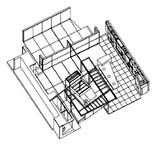 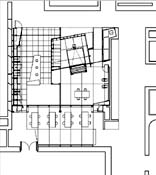 Plan. |
|||
|
LAWRENCE DAVIS. Children's Interactive Gallery. Everson Museum, Syracuse, New
York |
||||
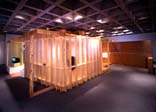 South-West corner. |
Client: Everson Museum of Art Sandra Trop (director) Marion Wilson (project director and curator of education) Architect: Lawrence Davis, architect Lawrence Davis (principle) Joshua Linkov (assistant) Construction: Everson Museum of Art William Waelder (manager of special projects) Richard Flood (assistant) |
|||
|
>
MUSEUM IN MOTION
> ARTLAND |
||||